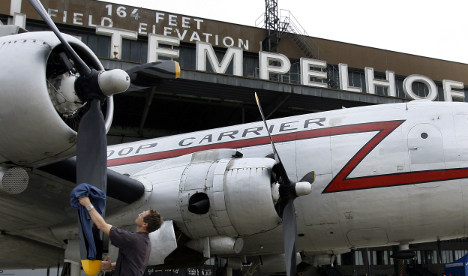Modern romance began with the film Casablanca. The smouldering saga of Bogart and Bergman had everything one needed to structure a 20th century emotional narrative: adultery, betrayal, forgiveness, jealousy, bribery and a spectacular parting.
I remember one horrific argument with a girlfriend in the 1970s which ended with her shouting: “I’m leaving the country – don’t try and follow me!” It was a line which surely would have earned a place in the sequel. But most of all I remember – as everybody does – the tragic departure in the airport.
Obviously, we all know that airport was not Berlin’s iconic Tempelhof, but every time I went to see someone off there I became a little bit more like Humphrey Bogart. It represented everything good about air travel and I don’t just mean the Berlin Airlift, that extraordinary model for humanitarian relief. Tempelhof was a reminder that Germany was at the spearhead of aeronautic innovation, and that Berlin used to be a creative hub for engineers, daring pilots, inventors, designers, pioneers.
If you need to refresh your memory, I can only urge you to visit the splendidly elegant Galerie Bassenge in Grunewald. It’s auction week there again and among the exhibits are original photographs, catalogues and old magazines that chart the beginnings of aviation in Germany.
Exactly 100 years ago, the first Deutsche Fliegerwoche was held on the airfield at Berlin-Johannisthal. Hubert Latham flew from Johannisthal to Tempelhofer Feld, building on the work of the Lilienthal brothers and the advances in Zeppelin technology. The first Internationale Luftfahrt-Ausstellung (ILA) air show was held in Frankfurt in 1909 but three years later, a much broader and exciting exhibition was being held in the halls next to the Berlin Zoo. Seven airships and 25 planes – it must have been huge.
All this largely forgotten history is recorded in the Bassenge exhibits. Those were the days when Germany really led the world and when hundreds of thousands of fascinated Berliners gathered in Tempelhof to watch Wilbur and Orville Wright fly round the field. The 20th century wars turned planes into weapons, but Berlin was still at the heart of aviation when the wars ended. Ullstein-Verlag and the BZ paper awarded huge prizes in the 1920s to German pilots – not because they were trying to subsidise a new air force for a new war but out of a love of sport and engineering achievement.
Now all that has been lost by closing Tempelhof as an airport last year. Yesterday’s news, you will say: the referendum has been lost, decisions taken. Well, I understand the city government’s plan for Schönefeld Airport, and I really do hope that it becomes a major East-West hub. But the plans for Tempelhof are the product of suburban minds, without flair: a housing estate, a park, a fashion fair.
Some of the most interesting ideas in circulation came from outside the closed circle favoured by the city. There’s the retired engineer Anton Heyne, for example, who has been trying to stir interest in having each major world religion (at its own cost) construct a house of worship on the Tempelhof premises. With a church, a mosque, a synagogue, and a Hindu temple operating is such close proximity, the faiths would be forced to interact.
This and other ideas are interesting but they also react only to Tempelhof as a very large urban space. What do you do with such emptiness? Fill it, of course, with big concepts. But many designers and planners are missing the point. Aeroplanes are the essence of Tempelhof. The referendum about its closure (however flawed) clinched the issue: it will never again be an airport. But Tempelhof could none the less upheld the spirit of flight, stay true to its history.
The obvious starting point is to make space available for a large – I would like to think Germany’s largest – aerospace museum. Real dynamism will only return to Tempelhof however if the ILA is shifted from Schönefeld to Tempelhof.
Next year will be the last in Schönefeld, because of the imminent opening of the new Berlin-Brandenburg International being built there. Though not currently in contention, Tempelhof is the perfect location, a reminder that there is continuity to German success.
The very first ILA a century ago lasted 100 days and attracted 1.5 million people. That is something to aim for – other big air shows, Farnborough in Britain, Le Bourget in Paris, attract major business deals but also help put financiers in touch with new ideas in aerospace.
Whatever happened to Cargolifter, the ambitious scheme to develop a new generation of freight airships? Zeppelins that could transport aid to earthquake zones? It went bankrupt, disappeared into the Brandenburg sand.
The Germans were once good at flying; now their wings have been clipped. Bring ILA back into the centre of the city, to an old airport that can still inspire the young, and maybe, just maybe, something will take off again in this city.



 Please whitelist us to continue reading.
Please whitelist us to continue reading.
Member comments